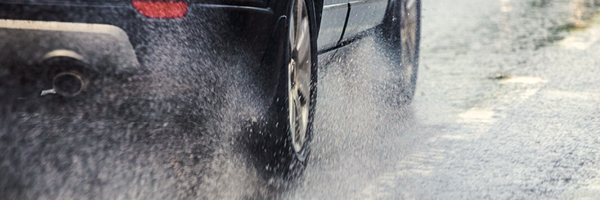
You could be driving around town running errands during a heavy rainfall or you could get caught in a storm during your commute to school or work. Heavy rain and standing water on the roads are a recipe for hydroplaning—and that means you could slide uncontrollably while you’re behind the wheel.
In this blog, you’ll learn what exactly hydroplaning is, how you can avoid the dangers of hydroplaning and the role your auto insurance can play in covering related accidents.
What is hydroplaning?
Also known as aquaplaning, hydroplaning occurs when you slide uncontrollably on wet roads. When a layer of water builds up between your tires and the road surface, the water reduces traction and prevents your vehicle from responding to steering and braking mechanisms.
What conditions make hydroplaning possible?
Hydroplaning is usually caused by heavy rainfall, but your location and your vehicle can also contribute to hydroplaning. For example, driving during heavy rainfall will increase your likelihood of sliding around, but driving with balding tires will increase the risk even more.
Here are a few scenarios where hydroplaning can happen and what you should do instead:
- You’re driving fast after a storm on some wet pavement. You hit a large puddle of standing water and hydroplane immediately, spinning out of control.
- Do this instead: Always drive the speed limit and drive cautiously around the standing water to avoid a dangerous spin out. If you need to reduce your speed to approach standing water safely, brake slowly. You may even need to switch lanes to avoid the water.
- You’re familiar with a shallow stretch of road in your town that tends to flood after heavy rainfall, and you’re approaching that spot. The area is full of standing water, but you decide to drive through while going the speed limit. After all, you’ve done it before, and the water doesn’t look that deep. This time, you start to rock back and forth while driving through the standing water. You lose control of your steering and glide into the next lane, hitting a nearby car.
- Do this instead: Always do your best to avoid driving through standing water. You don’t know for sure how deep it is until you’re already traveling through it. Change lanes or take an alternative route to your destination to avoid the standing water altogether. Additionally, always give yourself extra space around your vehicle from the front and sides when there are puddles of standing water. It can help you avoid a collision from hydroplaning.
- Your car is set on cruise control while you take a road trip. While you travel at high speeds, you lose traction on a stretch of wet pavement. You swerve but you are able to regain control of the steering when you turn off cruise control and brake.
- Do this instead: Avoid using cruise control on wet pavement.
Hydroplaning can occur at speeds as low as 35 mph according to Driving-Tests.org. Take it slow to minimize the risk of sliding while driving in the rain. Additionally, be sure to complete routine car maintenance for added safety. Rotating tires and replacing bald tires are essential for balanced tire tread and good traction.
Did you know four-wheel drive (4WD) and all-wheel drive (AWD) do not impact hydroplaning? Safe driving practices, quality tires and good tire tread are the best defense against sliding on wet roads.

Learn about our
Auto Insurance
Does insurance cover hydroplaning?
If you have collision coverage in your auto insurance policy, your insurance will likely cover the costs of the accident if you are determined at-fault. For a single car accident where hydroplaning makes you slide into a ditch, concrete barrier or guardrail, you may be able to file a claim for injuries or property damage.
Talk to your Grange Independent Agent to learn more about the specifics of your car insurance coverage.
How to stay safe after you start hydroplaning
If your vehicle begins to hydroplane, you should:
- Slow down—drive at a slower speed to minimize your risk of sliding or losing control.
- Pull over—pull over and park your car to wait out the heavy rain.
- Leave the area—if you can, try to leave the area and drive to higher, drier ground.
While it can be tempting to turn on your hazard lights during heavy rainfall, the experts at Firestone Complete Auto Care warn that you shouldn’t. If your flashers are on, it’s impossible to use your turn signal at the same time. A turn signal is more effective for letting other drivers know where you’re going—especially if you’re trying to get off the road or make an emergency stop.
References
Driving-Tests.org
Reader's Digest
Firestone Complete Auto Care
Coverages described herein may not be available in all states. Please contact a local independent Grange agent for complete details on coverages and discounts. If the policy coverage descriptions herein conflict with the language in the policy, the language in the policy applies. The material provided above is for informational, educational, or suggestion purposes and does not imply coverage. WE RESERVE THE RIGHT TO REFUSE TO QUOTE ANY INDIVIDUAL PREMIUM RATE FOR THE INSURANCE HEREIN ADVERTISED. Grange Insurance policies are underwritten by Grange Insurance Company, Trustgard Insurance Company, Grange Indemnity Insurance Company, Grange Insurance Company of Michigan and Grange Property & Casualty Insurance Company*. Not all companies are licensed in all states. *Not licensed in Pennsylvania.